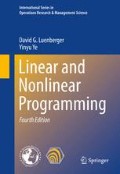Abstract
We first derive the duality theory of for constrained optimization, which is based on our earlier zero-order optimality conditions and the Lagrangian relaxations. The variables of the dual are typically the Lagrange multipliers associated with the constraints in the primal problem—the original constrained optimization problem.
Access this chapter
Tax calculation will be finalised at checkout
Purchases are for personal use only
Bibliography
D.P. Bertsekas, Nonlinear Programming (Athena Scientific, Belmont, 1995)
S. Boyd, N. Parikh, E. Chu, B. Peleato, J. Eckstein, Distributed optimization and statistical learning via the alternating direction method of multipliers. Found. Trends Mach. Learn. 3, 1–122 (2010)
C.H. Chen, B.S. He, Y.Y. Ye, X.M. Yuan, The direct extension of ADMM for multi-block convex minimization problems is not necessarily convergent. Math. Program. (2014). doi:10.1007/s10107-014-0826-5
B.C. Eaves, W.I. Zangwill, Generalized cutting plane algorithms. Working Paper No. 274, Center for Research in Management Science, University of California, Berkeley (July 1969)
J. Eckstein, D.P. Bertsekas, On the Douglas-Rachford splitting method and the proximal point algorithm for maximal monotone operators. Math. Program. 55, 293–318 (1992)
H. Everett III, Generalized lagrange multiplier method for solving problems of optimum allocation of resources. Oper. Res. 11, 399–417 (1963)
W. Fenchel, Convex Cones, Sets, and Functions. Lecture Notes (Department of Mathematics, Princeton University, Princeton, NJ, 1953)
M. Fortin, R. Glowinski, On decomposition-coordination methods using an augmented Lagrangian, in Augmented Lagrangian Methods: Applications to the Solution of Boundary Problems, ed. by M. Fortin, R. Glowinski (North- Holland, Amsterdam, 1983)
D. Gabay, B. Mercier, A dual algorithm for the solution of nonlinear variational problems via finite element approximations. Comput. Math. Appl. 2, 17–40 (1976)
R. Glowinski, A. Marrocco, Approximation par éléments finis d’ordre un et résolution par pénalisation-dualité d’une classe de problèmes non linéaires. R.A.I.R.O. R2 2, 41–76 (1975)
B.S. He, X.M. Yuan, On the O(1∕n) convergence rate of the Douglas-Rachford alternating direction method. SIAM J. Numer. Anal. 50, 700–709 (2012)
M.R. Hestenes, Multiplier and gradient methods. J. Opt. Theory Appl. 4(5), 303–320 (1969)
L. Hurwicz, Programming in linear spaces, in Studies in Linear and Nonlinear Programming, ed. by K.J. Arrow, L. Hurwicz, H. Uzawa (Stanford University Press, Stanford, CA, 1958)
S. Karlin, Mathematical Methods and Theory in Games, Programming, and Economics, vol. I (Addison-Wesley, Reading, MA, 1959)
J.E. Kelley, The cutting-plane method for solving convex programs. J. Soc. Ind. Appl. Math. VIII(4), 703–712 (1960)
D.G. Luenberger, Optimization by Vector Space Methods (Wiley, New York, 1969)
D.G. Luenberger, Introduction to Linear and Nonlinear Programming, 1st edn. (Addison-Wesley, Reading, MA, 1973)
R.D.C. Monteiro, B.F. Svaiter, Iteration-complexity of block-decomposition algorithms and the alternating direction method of multipliers. SIAM J. Optim. 23, 475–507 (2013)
M.J.D. Powell, A method for nonlinear constraints in minimization problems, in Optimization, ed. by R. Fletcher Powell (Academic, London, 1969), pp. 283–298
R.T. Rockafellar, The multiplier method of hestenes and powell applied to convex programming. J. Optim. Theory Appl. 12, 555–562 (1973)
M. Slater, Lagrange multipliers revisited: a contribution to non-linear programming. Cowles Commission Discussion Paper, Math 403 (November 1950)
D.M. Topkis, A note on cutting-plane methods without nested constraint sets. ORC 69-36, Operations Research Center, College of Engineering, Berkeley, CA (December 1969)
A.F. Veinott Jr., The supporting hyperplane method for unimodal programming. Oper. Res. XV 1, 147–152 (1967)
P. Wolfe, A duality theorem for nonlinear programming. Q. Appl. Math. 19, 239–244 (1961)
P. Wolfe, Convergence theory in nonlinear programming (Chap. 1), in Integer and Nonlinear Programming, ed. by J. Abadie (North-Holland Publishing Company, Amsterdam, 1970)
W.I. Zangwill, Nonlinear Programming: A Unified Approach (Prentice-Hall, Englewood Cliffs, NJ, 1969)
Author information
Authors and Affiliations
Rights and permissions
Copyright information
© 2016 Springer International Publishing Switzerland
About this chapter
Cite this chapter
Luenberger, D.G., Ye, Y. (2016). Duality and Dual Methods. In: Linear and Nonlinear Programming. International Series in Operations Research & Management Science, vol 228. Springer, Cham. https://doi.org/10.1007/978-3-319-18842-3_14
Download citation
DOI: https://doi.org/10.1007/978-3-319-18842-3_14
Publisher Name: Springer, Cham
Print ISBN: 978-3-319-18841-6
Online ISBN: 978-3-319-18842-3
eBook Packages: Business and ManagementBusiness and Management (R0)

